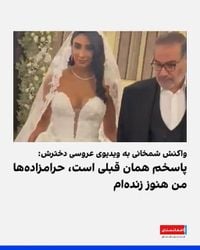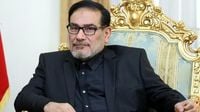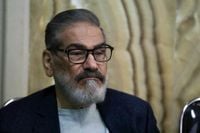On the evening of October 19, 2025, a unique cultural event unfolded simultaneously in two cities—Moscow and Yadavar—marking the public release of the film Arousie Dokhtar Shamhani (translated as "Shamkhani's Daughter's Wedding"). This film, described by multiple Iranian news outlets as a rare and distinctive artistic achievement, was born from a collaboration between Iranian and Russian filmmakers, aiming to spotlight the growing cultural and diplomatic ties between the two nations.
The anticipation surrounding Arousie Dokhtar Shamhani had already reached a fever pitch by the time the lights dimmed in the theaters. According to Khabar Online, the film was not merely a cinematic project but a symbol of unity and cooperation, bridging artistic sensibilities from Tehran to Moscow. The simultaneous screenings in both capitals underscored this message of cross-cultural partnership.
Yet, the film’s debut did not occur in a vacuum. In the days leading up to its release, social media in Iran was abuzz with controversy over leaked footage from the real-life wedding of Ali Shamkhani’s daughter. Shamkhani, a prominent member of Iran’s Supreme National Security Council and former secretary of the body, found himself at the center of a storm after private videos from the April 2024 wedding at Tehran’s Espinas Hotel surfaced online. Media outlets, including Eghtesad News and Eqtesad Online, reported that the wedding’s opulent scale—rumored to have cost billions of tomans—sparked heated debates about hypocrisy and extravagance among public officials.
The footage showed Shamkhani accompanying his daughter and her husband during the women’s section of the wedding, later joining the groom for a commemorative photo. Despite the event’s separation of genders, traditional and religious segments of Iranian society criticized the modern attire of Shamkhani’s daughter and wife, which they saw as reflecting the values of the secular middle class rather than those of the country’s conservative establishment.
The backlash was swift and sharp. The controversy was further fueled by claims, reported by Eqtesad Online, that the video had initially been disseminated by accounts linked to Israel, though subsequent investigations by Fars News suggested the first leak originated from monarchist opposition circles. The timing of the leak, years after the actual event, left many Iranians speculating about its motives—some even tying it to internal rivalries or recent incidents involving Iranian oil traders.
Ali Shamkhani, known for his blunt demeanor, responded to the uproar with characteristic directness. In an interview at the funeral of General Alireza Afshar—an event attended by numerous political and military figures—he told a Fars News reporter, “My answer to the recent commotion is the same as before: Bastards, I’m still alive.” He later echoed this message on social media, posting in both Persian and Hebrew: “Bastards, I’m still alive!” The use of such strong language only intensified public debate, with some seeing it as defiance and others as evidence of a political double standard.
Political figures and commentators across the spectrum weighed in. Former Minister of Cultural Heritage, Ezzatollah Zarghami, defended Shamkhani, writing, “It was a private and entirely women’s event; the father of the bride, according to his tribal customs, placed his daughter’s hand in the groom’s. He kept his head down.” Meanwhile, the conservative student news agency Daneshjoo warned that “the dissemination of these images, and the possible extension of this narrative by parts of the public to other officials and even senior figures of the system, is unjust to many martyrs and prominent colleagues of Ali Shamkhani who live simply and chastely.” The agency added that the controversy had pitted public opinion against the private lives of officials.
On the reformist side, political activist Saeed Shariati criticized the outcry over the leak, pointing out what he saw as hypocrisy within the system: “In a country where security agencies use the broadcast of private footage and confessions as one of their main tools, the voices of those condemning the leak of the private wedding video of the former Supreme National Security Council secretary’s daughter will not be heard. Mr. Shamkhani, you yourself are responsible for the ugly situation that has arisen. There was a time when you could have prevented these actions on state television, but you did not.”
Journalist Vahid Hajipour, known for his coverage of Iran’s oil sector, speculated that the leak might be related to internal competition among oil traders, referencing the coincidental timing with an LPG tanker explosion. “Who knows, maybe the release of Shamkhani’s daughter’s wedding video is part of domestic rivalries among oil traders trying to eliminate each other. The timing with the LPG ship explosion is interesting! Only God knows!” he remarked.
Amid the media storm, the film’s screening in Tehran took on added significance. According to Eqtesad News, the Imam Sadegh Mosque hosted the event, with Ali Shamkhani and Hassan Rezaei in attendance. The film was praised for its artistic value and its role in fostering dialogue and understanding between Iran and Russia. Visual presentations during the screening emphasized the depth of cooperation and friendship between the two countries, a point not lost on many observers given the current geopolitical climate.
Commentators like Rouhollah Jamahi, writing for Khabar Online, drew parallels between the leak of the wedding video and the infamous release of former Foreign Minister Mohammad Javad Zarif’s audio recordings at the end of the previous administration. Jamahi warned, “Be careful; the unethical and divisive release of the wedding video of a senior official’s daughter, especially after disputes with former government officials, is reminiscent of the release of Zarif’s audio file at the end of the thirteenth government—a file that angered Russia and Russophiles.” He added, “Recently, the Russians have also come under serious criticism. Many, including Russia and Israel, are not seeking calm and stability in Iran!”
Despite the swirl of controversy, the film Arousie Dokhtar Shamhani has managed to carve out a space for itself as a cultural artifact and a symbol of international collaboration. Its release, set against a backdrop of political intrigue and public debate, serves as a reminder of the complexities that define contemporary Iranian society—where art, politics, and private life are often inextricably intertwined.
As the credits rolled in both Moscow and Yadavar, and as the conversation continued to rage online and in the press, one thing was clear: the intersection of culture and controversy in Iran remains as dynamic—and unpredictable—as ever.






